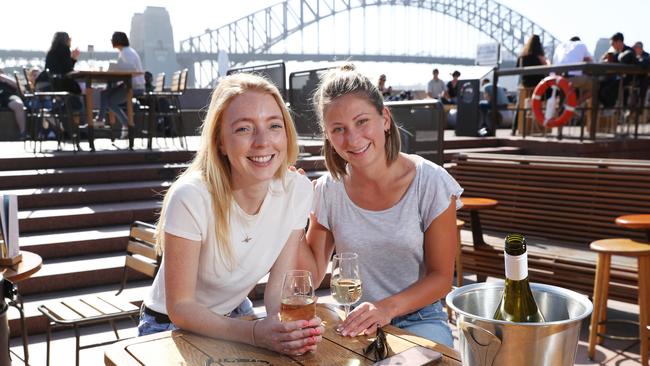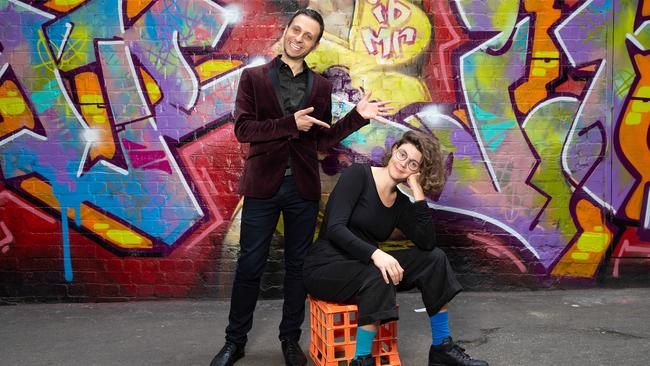Lockout laws lead slump in night time economy for Sydney
Melbourne’s night-time economy is growing at twice the rate of Sydney’s — just one of a spate of warning signs that the Harbour City is being overtaken by the Victorian capital.
NSW
Don't miss out on the headlines from NSW. Followed categories will be added to My News.
Melbourne’s night-time economy is growing at twice the rate of Sydney’s — just one of a spate of warning signs that the Harbour City is being overtaken by the Victorian capital.
From planning to events, to retail spending, restaurants and population growth, Sydney is lagging behind its southern counterpart on a range of markers of a successful city.
“Sydney is the best city to live in Australia but we risk losing our edge with issues like the lock-out laws stifling the night-time economy and affecting tourism,” Katherine O’Regan, Executive Director of the Sydney Business Chamber said.

Figures released by the Local Government Safe Cities Network show Melbourne’s night-time economy pumped more jobs, money and sheer fun into its economy than Sydney’s darkened, empty streets.
And it’s the same story with important economic indicators including population and housing prices.
“Sydney needs to remain a great city of opportunity for living, doing business and attracting and entertaining international tourists. Repealing the CBD lockout laws is a critical first step toward realising these opportunities,” Ms O’Regan said.
“To really get the night right in Sydney we need to have a distributed evening economy. Things to do for all ages from Manly to Marrickville, Pyrmont to Penrith,” she said.
A cross-party committee set up by Premier Gladys Berejiklian is due to report back on the lockout laws within a couple of weeks. Yesterday the Premier said she believed the laws, set up in the wake of a string of alcohol-fuelled attacks, should be “relaxed or repealed”.
“We know we need to enhance Sydney’s night-life and build on the work we have done to grow investment and jobs,” she said.
“The Sydney CBD has changed dramatically and matured over the last five years since the lockout laws were introduced, and I look forward to the advice of the committee due to report in the next few weeks … but it’s clear we need to take action to ensure Sydney remains a vibrant global destination.”
For many that cannot come soon enough. Melbourne Lord Mayor Sally Capp crowed yesterday: “Our city’s night-time economy grew by $310.3 million last year, which means greater opportunities for local business and more jobs.” That is a rate of growth that dwarfs Sydney’s, which only increased by $234 million, and allowed Ms Capp to boast: “These figures demonstrate that Melbourne is Australia’s events and cultural capital.”
Sydney has seen a spate of fine dining restaurant closures since the lockout laws, including Longrain and the three hatted Marque in Surry Hills, Guillaume in Paddington and Neil Perry’s Rockpool. In the last year there has been a tiny one per cent growth in food establishments in Sydney while Melbourne has seen a 4.8 per cent jump, contributing $2.2 billion to the city economy.
And Sydney has struggled to attract hit shows such as Harry Potter and the Cursed Child with the closure of the Theatre Royal leaving it with just two suitable venues compared to Melbourne’s four.
Jason Marriner, whose Marriner Group owns four of Melbourne’s most prestigious theatres, including the Princess and Regent Theatres, said Sydney was paying for mistakes made decades ago.
“At a time in history when Melbourne’s theatres could have been demolished during the late 70s, early 80s they were saved while they were demolished in Sydney and what we’ve since come to realise is that they’re irreplaceable,” he said.
And the more people who go to Melbourne, the more they love it. Harry Potter actor Lucy Goleby is a convert to her new home. “I do miss Sydney but I love Melbourne,” she said. “I think the lockout laws have had a pretty negative impact on Sydney.”
Melbourne’s night-time entertainment venues grew by 6.2 per cent but in darkened Sydney they crept up by just 0.9 per cent.
Patrick Donovan, CEO of Music Victoria, said: “Melbourne has the most live music venues per capita in the world with 533 venues which host different styles of music every night of the week.”

Sydney comedian Harriet Gillies, who is performing at the Melbourne Fringe Festival, said the Victorian capital had a vibrant arts scene. “It’s my second home because as a performer the city has a really strong and supportive arts culture.”
Rich lister Justin Hemmes, owner of The Ivy, told a parliamentary inquiry into lockout laws that Sydney’s night- time economy is an “embarrassment”. He said the laws had forced his venues to turn away celebrities including Madonna and Justin Bieber.
Emily Andrew, 29, and Catherine King, 31, from Manly, are both fans of Melbourne. “From a night-life perspective, I think Melbourne would have more to offer,” Ms King said.
Committee for Sydney chief executive Gabriel Metcalf said: “The numbers tell a clear story, Sydney is missing out on a great opportunity.
“The good news is that this government has signalled that it’s going to scale back the lockout laws. Hopefully that is just the first step,” he said. “For the Sydney economy to keep going what we will need to be looking to is things beyond night-time and address issues like transport, which Sydney is doing a good job on, and housing costs which we need to a better job on.”
Sydney has the longest average daily commute time in Australia at 71 minutes compared to 65 minutes in Melbourne. Eight out of the top 10 most congested roads in Australia are in Sydney compared to just one in Melbourne.
And it costs more to live in Sydney. House prices are 37 per cent higher with the average home in Sydney costing $843,994 while in Melbourne a typical house costs $615,068. Tighter planning restrictions add an average of $150,000 more to the cost of a two-bedroom apartment in Sydney.
Chris Johnson, chief executive of the Urban Taskforce, said red tape was choking Sydney’s potential.
“There is a lot of red tape cutting that needs to happen in Sydney that can open allow more homes to be built and open up more population growth,” Mr Johnson said.
“At the moment Melbourne’s population growth is 2.18 per cent compared to 1.56 per cent in Sydney and that puts Melbourne on track to be bigger than Sydney in the next decade.”
And more people want to visit south of the border. In the last year more people from Sydney — 83,600 — stayed in Melbourne than the 80,200 who came the other way.
editorial page 38
